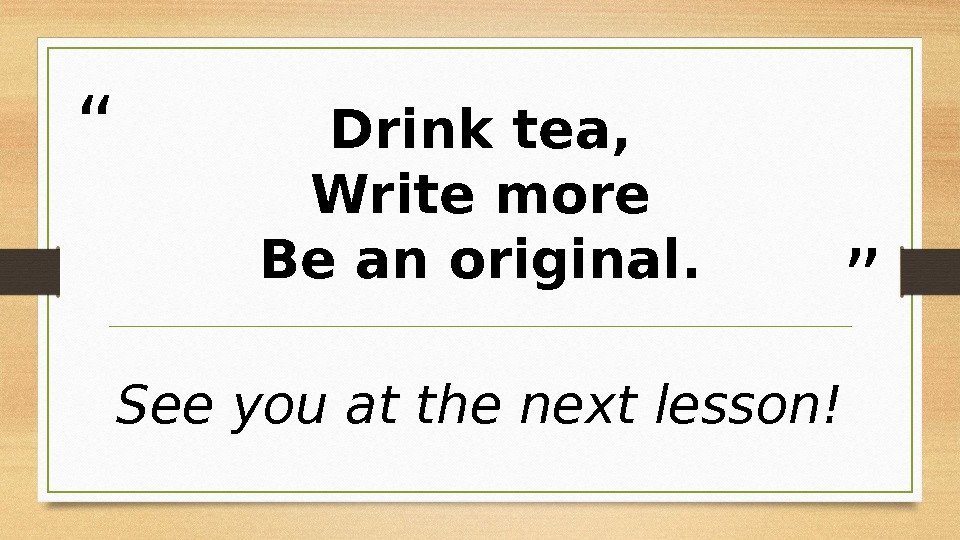SELF-EXPRESSIO N: HOW DO YOU LIKE?














3.ppt
- Размер: 14.7 Мб
- Автор:
- Количество слайдов: 14
Описание презентации SELF-EXPRESSIO N: HOW DO YOU LIKE? по слайдам

 SELF-EXPRESSIO N: HOW DO YOU LIKE?
SELF-EXPRESSIO N: HOW DO YOU LIKE?


 Expository Descriptive Argumentative Narrative — requires to investigate an idea, evaluate evidence, and set an argument in a clear manner Please note : commonly assigned as a tool for classroom evaluation and found in various exams. — describe something—object, person, place, experience, emotion, situation, etc. Encourages you to develop artistic freedom — requires to investigate a topic; collect, evidence. Some confusion — the argumentative essay is a final project and involves lengthy, detailed research. Expository essays involve less research and are shorter in length. — Storytelling. Anecdotal, experiential, and personal—allowing to express yourself in a creative and dynamic ways.
Expository Descriptive Argumentative Narrative — requires to investigate an idea, evaluate evidence, and set an argument in a clear manner Please note : commonly assigned as a tool for classroom evaluation and found in various exams. — describe something—object, person, place, experience, emotion, situation, etc. Encourages you to develop artistic freedom — requires to investigate a topic; collect, evidence. Some confusion — the argumentative essay is a final project and involves lengthy, detailed research. Expository essays involve less research and are shorter in length. — Storytelling. Anecdotal, experiential, and personal—allowing to express yourself in a creative and dynamic ways.
 Opinion Questions What is your opinion? Do you agree or disagree? To what extent do you agree or disagree? Example Question – Some people believe that volunteering should be a compulsory part of high school programs (working for a charity, improving the neighborhood or teaching sports to younger children). To what extent do you agree or disagree?
Opinion Questions What is your opinion? Do you agree or disagree? To what extent do you agree or disagree? Example Question – Some people believe that volunteering should be a compulsory part of high school programs (working for a charity, improving the neighborhood or teaching sports to younger children). To what extent do you agree or disagree?
 Introduction: Sentence 1 – Paraphrase Question Sentence 2 – Thesis Statement (It is agreed/disagreed… This essay agrees/disagrees) Sentence 3 – Outline Sentence (This essay will discuss) It is argued that volunteering should be made part of the school curriculum. This essay agrees with that suggestion completely because of the benefits it brings to pupils. The essay will first look at how voluntary work can help students develop soft skills and then discuss how these extracurricular activities are valued by universities and employers.
Introduction: Sentence 1 – Paraphrase Question Sentence 2 – Thesis Statement (It is agreed/disagreed… This essay agrees/disagrees) Sentence 3 – Outline Sentence (This essay will discuss) It is argued that volunteering should be made part of the school curriculum. This essay agrees with that suggestion completely because of the benefits it brings to pupils. The essay will first look at how voluntary work can help students develop soft skills and then discuss how these extracurricular activities are valued by universities and employers.
 Main Body: Paragraph 1 Sentence 1 — Topic Sentence 2 — Explain Topic Sentence 3 — Example. Education should not be limited and those in education should also develop life skills, such as teamwork, empathy and self-discipline, and one of the best ways to do this is through community service. Serving those less fortunate than ourselves teaches us many lessons including how to work with people from other backgrounds and the value of hard work. For example, I I personally volunteered to spend 6 weeks in Africa teaching disadvantaged children and this led to a much higher work ethic when I returned to my studies.
Main Body: Paragraph 1 Sentence 1 — Topic Sentence 2 — Explain Topic Sentence 3 — Example. Education should not be limited and those in education should also develop life skills, such as teamwork, empathy and self-discipline, and one of the best ways to do this is through community service. Serving those less fortunate than ourselves teaches us many lessons including how to work with people from other backgrounds and the value of hard work. For example, I I personally volunteered to spend 6 weeks in Africa teaching disadvantaged children and this led to a much higher work ethic when I returned to my studies.
 Main Body: Paragraph 2 Sentence 1 — Topic Sentence 2 — Explain Topic Sentence 3 — Example Many colleges and companies are also increasingly looking for this type of experience. Most school leavers have the same grades and charitable works can help set you apart from the herd. For example, Cambridge and Oxford receive thousands of applications from straight-A students every year and can only accept a small percentage of applicants. What you have done outside the classroom is often the thing that differentiates you from everyone else and gets you that coveted spot.
Main Body: Paragraph 2 Sentence 1 — Topic Sentence 2 — Explain Topic Sentence 3 — Example Many colleges and companies are also increasingly looking for this type of experience. Most school leavers have the same grades and charitable works can help set you apart from the herd. For example, Cambridge and Oxford receive thousands of applications from straight-A students every year and can only accept a small percentage of applicants. What you have done outside the classroom is often the thing that differentiates you from everyone else and gets you that coveted spot.
 Conclusion: Sentence 1 — Summary and opinion In conclusion, teenagers should be made to partake in unpaid work as part of their schooling because it will help them learn things they wouldn’t ordinarily learn from their teachers and it will also boost their chances of getting into third level education.
Conclusion: Sentence 1 — Summary and opinion In conclusion, teenagers should be made to partake in unpaid work as part of their schooling because it will help them learn things they wouldn’t ordinarily learn from their teachers and it will also boost their chances of getting into third level education.
 Structure: — Introduction Sentence 1 — Paraphrase Question Sentence 2 — Outline Sentence — Main Body Paragraph 1 Sentence 1 — State One Advantage Sentence 2 — Expand/Explain Advantage Sentence 3 — Example Sentence 4 — Result — Main Body Paragraph 2 Sentence 1 — State One Disadvantage Sentence 2 — Expand/Explain Disadvantage Sentence 3 — Example Sentence 4 — Result — Conclusion Sentence 1 — Summary Sentence 2 — Opinion
Structure: — Introduction Sentence 1 — Paraphrase Question Sentence 2 — Outline Sentence — Main Body Paragraph 1 Sentence 1 — State One Advantage Sentence 2 — Expand/Explain Advantage Sentence 3 — Example Sentence 4 — Result — Main Body Paragraph 2 Sentence 1 — State One Disadvantage Sentence 2 — Expand/Explain Disadvantage Sentence 3 — Example Sentence 4 — Result — Conclusion Sentence 1 — Summary Sentence 2 — Opinion
 + Linking words!
+ Linking words!

 “ ”Drink tea, Write more Be an original. See you at the next lesson!
“ ”Drink tea, Write more Be an original. See you at the next lesson!
